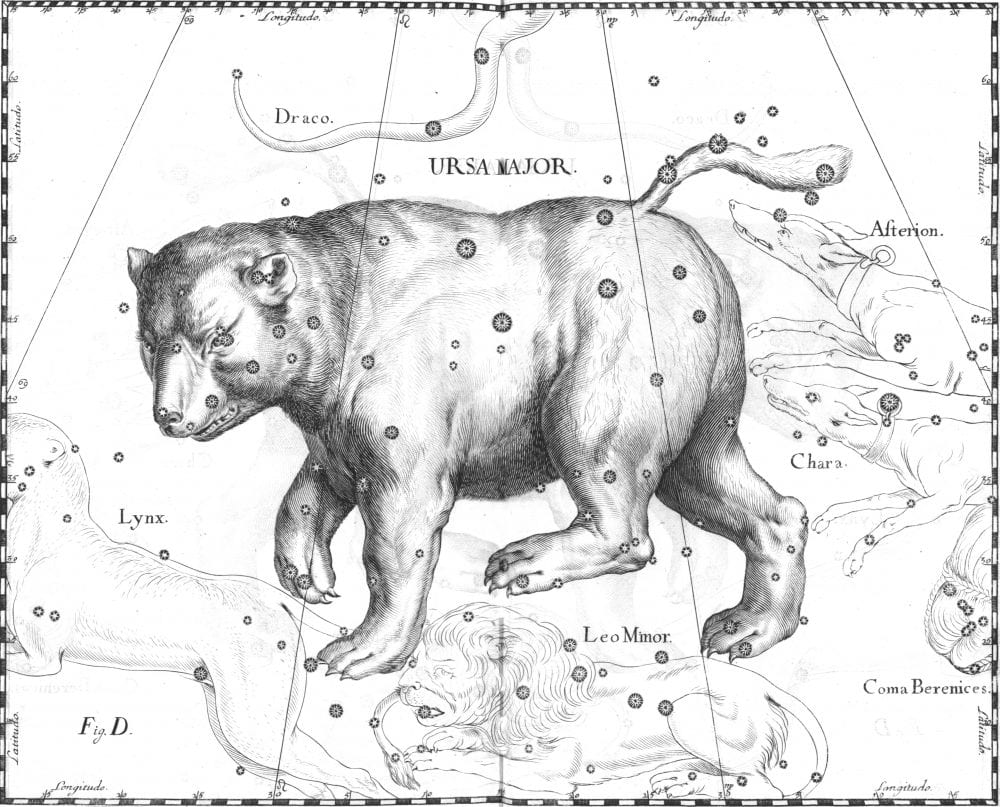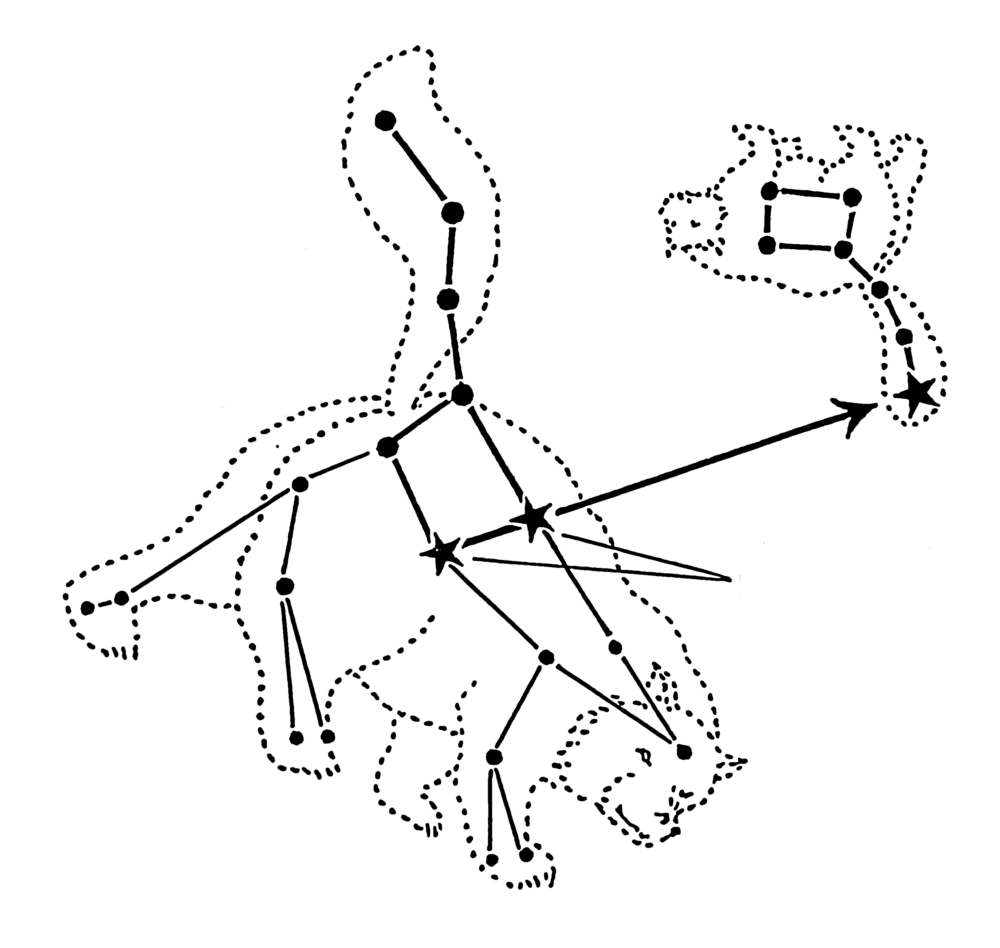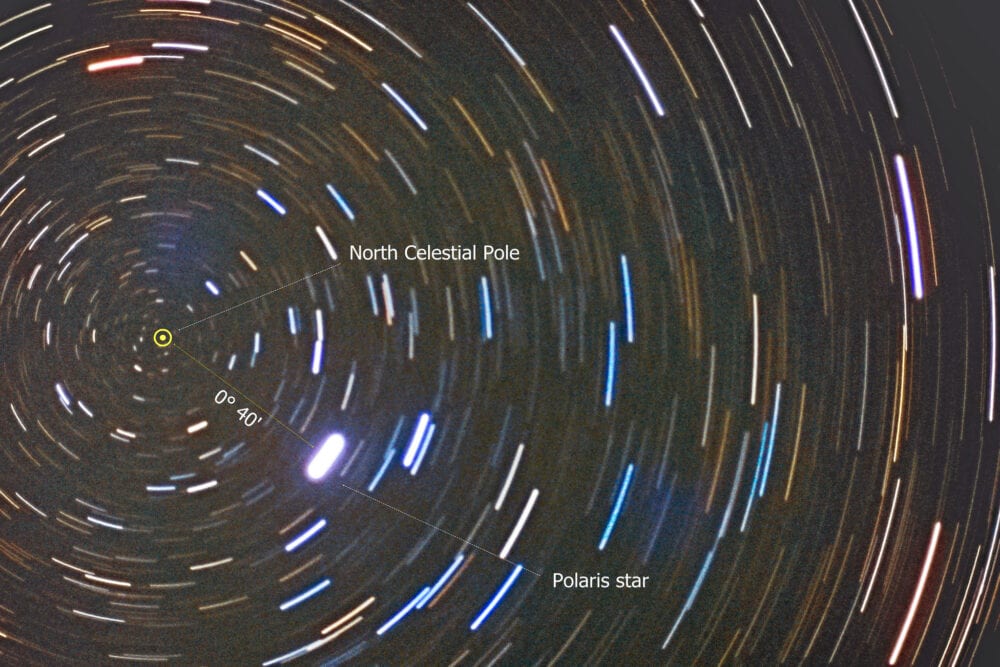
By Elizabeth Watts, Educator
Most of the time when you go outside at night, you don’t want to encounter any bears. However, there are always bears around if you know where to look — up in the stars! Luckily these bears won’t be bothered by your presence.
The bears are the constellations known as Ursa Major and Ursa Minor, or the Greater Bear and the Lesser Bear. The stars that make up these constellations are almost always visible in the northern hemisphere. While the Greeks, Romans, and Native people of the Americas saw bears, other cultures saw a wagon, a plough, a coffin, and many other things. Since this is Bear Fest, we’ll focus on the bear stories.

The written history of Ursa Major and Ursa Minor goes back thousands of years. Ptolemy listed Ursa Major and Ursa Minor as one of 48 constellations in one of the earliest surviving books on astronomy. It is mentioned in even earlier works, such as a poem by Aratus in 275 BCE. In this blog post, the author lists myths going back even farther in history.
As with many stories from history, there is more than one version of the myth of Ursa Major and Ursa Minor. One version is that Ursa Major represents Callisto who had a child with Zeus, king of the Greek gods. When Zeus’ wife, Hera, found out, she turned Callisto into a bear. Then one day Callisto’s son was out hunting and saw a great bear, not realizing it was his mother. To save them both Zeus threw them into the sky. Callisto became Ursa Major and her son, Arcus, became Ursa Minor. In other stories, Zeus turned Callisto into the bear to hide her from Hera. Other stories use the Roman form of the gods, Jupiter and Juno.
The bears in ancient Greece were Eurasian brown bears that are related to the grizzly bears found in North America. These bears are different from the black bears that live in New Mexico. Currently, there are estimated to be 450 brown bears living in the mountains of Greece. In general, bears are in declining numbers in Europe due to loss of habitat, but several groups in Greece are working to protect their bears.
In the drawing of Ursa Major based on the Greek myths, many people notice something unusual — the bear’s tail! Bears did not have long tails like this, even thousands of years ago. One story says that when Zeus threw the bear into the sky, he stretched out its tail. Interestingly, some of the Native people in the Americas told stories of a bear in this collection of stars. However, they did not see the handle of the dipper as a giant bear tail. Instead, the stars were seen hunters that were following the bear. As with the Greek and Roman myths, there are many versions of this story amongst Native people. Here is one version of an Iroquois story of the Hunting of the Great Bear.
You can also watch a video version of the Never Ending Bear Hunt from the Smithsonian National Museum of the American Indian. Many other stories explain these stars, like this legend from the Cheyenne people about the Big Dipper called “The Quillwork Girl and Her Seven Brothers.”
Many of us are familiar with the Big Dipper. This group of stars is visible all year even in places with light pollution and is very recognizable. The dipper is not a constellation itself, but is called an “asterism” which is a collection of stars. While the Big Dipper is part of Ursa Major, it is not all of it. In the picture above you can see the dipper is just part of the larger bear. The Big Dipper is also known by other names around the world, such as the Plough, the Seven Sages, a boat, a salmon net, and others.

In addition to the fact that the Big Dipper is so easy to find, another reason this asterism is so widely known is that it helps people find north. Look at the above illustration of the two bears. The two stars at the end of the “bowl” of the Big Dipper point to Polaris, the North Star. Polaris also happens to be the end of the tail of the Little Dipper, but it is much easier to find the Big Dipper first.
In the last photograph, you can see all the stars rotating around the North Celestial Pole. Polaris is also shown so you can see how close it is to lining up with the pole. If you can find Polaris at night you can figure out what direction you are going.
Since the Big Dipper rotates around Polaris, you can use its position to approximate what time it is! Here’s an article on how to make your very own star clock. Try it out if you go camping or just in your own backyard. Just try not to disturb any wildlife that may also be out at night, like a real bear!
Also remember when you are looking at the stars that it is fun to look for constellations that other people recognize, but it is also fun to look for your own patterns in the stars. Maybe you can write your own story from what you see in the stars and send it to us!

Wonderful and informative comment thanks jbw